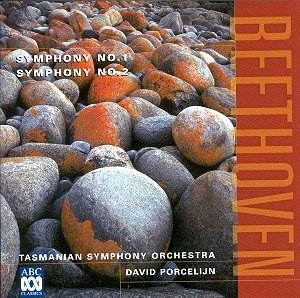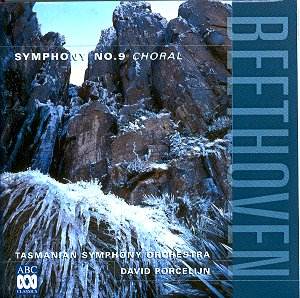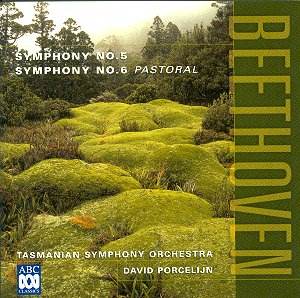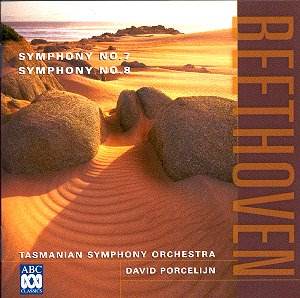This is certainly a most handsome looking and beautifully
presented set of the nine Beethoven symphonies. At mid-price these discs
are available either separately or in a handsome slipcase. Each disc
is contained in its own jewel case with a beautiful photograph of Tasmanian
scenes by the late Peter Dombrovskis. The symphonies are presented in
numerical order, two to a disc apart from the Ninth which has a disc
to itself: no unwanted overtures or extra fillers. And the discs are
superbly annotated.
The booklet tells us that the conductor David Porcelijn
is Dutch and "Öhas a notable career in Europe and Australia."
This may be so, but I must confess I had never heard of him and suspect
the same may be true for other collectors too. So would it be reasonable
to hand over our hard-earned cash for a set of Beethoven symphonies
from the present team when so many others, far better known, are jostling
for attention?
Among the hundreds of choices available the sets by
Mackerras, recently issued on Classics for Pleasure, and Zinman, on
Arte Nova, seem particularly interesting and inexpensive. I havenít
heard all of these, but those I have heard are outstanding. Béla
Drahos conducts the series on Naxos and the results are never less than
satisfactory, and often, as in the case of the Ninth, much more than
that. Set apart even from all these are Klempererís classic performances
from the late 1950s, an astonishing bargain on nine EMI discs which
also include the young Daniel Barenboimís marvellous set of the piano
concertos with the same conductor.
The feature of the present performances which is not
shared by any of the competitors is the presence of a fortepiano continuo.
There is a short but interesting article by David Garrett explaining
the reasoning behind this, and this is not the place to argue the pros
and cons in detail, even if I felt sufficiently historically informed
to do so. All the same the argument for using the fortepiano seems to
be no more than the fact that this was often the case into the early
1840s, and even Mr. Garrett admits that there is evidence that it was
not used in the earliest performances of the last symphonies. Itís an
interesting idea, though, and certainly gives rise to some surprises
beginning with the introduction to the First Symphony. In fact the instrument
doesnít play Ė or is inaudible Ė for much of the time, but there are
occasions, particularly in the later symphonies, where it takes some
getting used to. The meadows scene in the Pastoral is one example,
and especially in the Fifth, in the opening bars first of all, and then
in the rapid quaver section of the scherzo where the effect is frankly
odd. Whether or not the employment of the instrument disturbs the listener
it seems to me unarguable that it is not strictly necessary. The textures
are complete, even in the earlier works, and in those places where it
has been decided that the continuo will play a prominent role, one has
never before been aware of anything missing in the musical texture.
Now this may be because we are simply used to hearing it like that,
but I donít think so: hearing it with the continuo in place does not,
in the last analysis, cause us to exclaim "Of course! Why has nobody
ever done it like this before!"
So Iím afraid the use of the fortepiano continuo as
the Unique Selling Point of this set wonít quite do, and itís just as
well that the set boasts many other interesting features. First of all
there is the quite outstanding accompanying material: each disc features
an interesting article by Anthony Cane entitled "Beethoven and
the Age of Revolt" Ė the same article with each disc Ė but where
the set really scores is the analytical notes introducing each symphony,
which are clear, lucid and extremely informative.
Like the conductor, the Tasmanian Symphony Orchestra
was new to me, but it is an excellent group in every way. To judge from
the sound on these discs the strings were relatively few in number for
these performances, and if the result seems sometimes lacking in weight
this is not always a disadvantage, and is in any case all of a piece
with the interpretations. There is a clear gain from the point of view
of articulation and ensemble, which is almost always outstanding. Listen
to the strings in the finale of the First Symphony, both the fast solo
passages from the violins and the rapid accompanying figures and you
will hear what I mean. There are clearly many very fine players indeed
in the wind sections too, and though this is a modern instrument ensemble,
the playing is tempered by attention to period playing style, and the
result is extremely satisfying. The timpani are prominent throughout
which also contributes to a sense of drama not always found in other
interpretations. The editions used are cited in detail, and for the
most part are the new Bärenreiter editions edited by Jonathan del
Mar, which are also used by David Zinman in his Arte Nova set.
David Porcelijnís view of the Beethoven symphonies
is more or less consistent throughout the set. Tempi are on the rapid
side, especially of the slow movements where he rarely allows the music
to linger. He avoids any suspicion of slower tempi in the trio sections
of the scherzi, but there is a certain amount of rubato, in the horn-dominated
trio of the Eroica scherzo, for example. All marked repeats are
respected. He is perhaps more interested in clarity and articulation
than in massiveness and weight, which is as valid a way of seeing this
music as any other, and you will respond to it more or less according
to your own view of these works. All these features are evident in the
First Symphony, whose finale positively fizzes with life. It
is in such movements that for all his granite-like strength, the limitations
of Klempererís approach are most evident. Much the same may be said
of the finale of the Second Symphony, where even more, as well
as in the first movement, the virtuosity of the strings is much in evidence,
both in melodic passages and in rapid accompanying figures.
The Third Symphony receives an excellent performance
which manages very well to combine the twin virtues of clarity and strength.
The heavy, syncopated chords at the end of the first movement exposition
are as weighty as you could wish for, with accents superbly incisive,
and if the level of tension drops slightly at certain points in the
development section the conductor whips up his orchestra to make a fearsome
noise towards the end. Itís all very convincing, though you wonít hear
the sheer wildness of Bernstein in his celebrated New York version on
Sony (originally CBS). I donít think Iíve ever heard the double basses
make quite such an eerie noise at the beginning of the slow movement
as I did here, though the movement as a whole is perhaps not quite funereal
enough, with some accompanying figures jaunty rather than sombre. The
scherzo and finale are both excellent, though here again there is perhaps
a slight lack of abandon compared to the very finest readings, and I
find the Porcelijn doesnít quite find the way of integrating the slower
passage of the finale into the movement as a whole, and the coda lacks
a sense of finality and inevitability as a result.
The most successful passages in the reading of the
Fourth Symphony are undoubtedly those which are most rapid and
robust. The slow introduction to the first movement is rather literal
and lacking in mystery, but from the beginning of the main allegro the
conductor sets a cracking pace which never lets up, and the rest of
the movement is quite extraordinarily dramatic and successful. The conductorís
refusal to linger brings its own problems in the slow movement, but
the main reason why this movement seems less successful is the difficulty
the group have sometimes in making something significant out of the
accompanying figures in the strings. Solo instruments are always most
eloquent and well shaped, but the underlying rapid, short note scale
passages are ordinary and lacking in character and purpose. Purpose
returns with a vengeance in the scherzo, though the trio could have
been more lilting. The finale is a riot of good nature and exciting
high spirits, quite brilliantly played by the Tasmanian ensemble, their
string section demonstrating once again an excellent unanimity of attack
and articulation.
The Fifth Symphony is seen and played as a logical
continuation of the earlier symphonies rather than as a sudden and quite
separate revolutionary gesture. There is thus a certain lightness of
touch which many will find unconvincing, though it is important to stress
that this does not mean that the drama, nor even the power of the piece
is absent. The scherzo is very rapid and the quaver passage for cellos
and basses, difficult to make convincing at the best of times, sounds
somewhat grotesque at this speed, an impression not helped by the presence
of the fortepiano. There isnít much mystery about in the passage leading
into the finale and we therefore note a consequent lack of triumph in
the finaleís opening notes. The edition used here will surprise listeners
who have never heard it, as the repeats in the scherzo are not at all
what we are used to.
The Pastoral is a delight throughout,
always in keeping with the overall view of the series, providing a storm,
for instance, where bite and accent are favoured over weight and power.
The dancing and singing is beautifully done.
One of the earliest LPs I ever bought was of Beethovenís
Seventh Symphony. It was on the Wing label and Paul Paray conducted
(I think) the Minneapolis Symphony Orchestra. Unfortunately my entire
collection was stolen from a London student flat in 1971 and I havenít
heard that performance since, but I have memories of a view of Beethoven
perhaps compatible with the conductorís Gallic origins. I remember in
particular how the first flute positively sang the first subject of
the first movement allegro without for one moment sacrificing the rhythmic
drive which is so important in that melody and, of course, in the whole
symphony. The principal flute of the Tasmanian Symphony Orchestra doesnít
quite achieve that, but the playing shares a sense of style with the
version I wore out so many years ago. That said, the reading of the
Seventh Symphony is one of the less successful of the present
series. Where elsewhere the conductorís refusal to tarry may be seen
as a strength, here, especially in the opening slow introduction, the
playing seems finally to lack weight and import. Neither is he totally
successful in maintaining the excruciatingly difficult dotted rhythm
in the first movement allegro. The second movement is taken relatively
quickly Ė though the booklet notes suggest that "Beethoven showed
himself anxious [it] should not be taken too fast Ė and the conductor
does not allow himself even a little affectionate ritenuto on the four
rising notes with which the movement ends. The trio of the third movement,
again all of a piece with the conductorís view, slows very little from
the basic tempo, but much more important than that is a shortage of
strength, of muscle in the sound. Much the same may be said of the finale,
excellent though the playing is. Everything is in place, but the team
donít seem to be able to inject much meaning into those repeated rhythmic
figures, and the result is a reading of the Seventh where the clarity
of texture we have by now come to expect brings with it a serious lack
of power.
Just as Porcelijn seems to see the Eroica in
the context of the first two, more classically oriented symphonies,
so he places the Eighth Symphony squarely in the final series
of three. His reading runs for twenty-four minutes, but the result is
anything but small. Through a careful control of forte and accent
the reading is sharply dramatic in the first movement, with superbly
incisive horns. The finale too, is very driven and the string articulation
in rapid passages is for once less than impeccable. The conductor is
clearly so convinced of what he is doing that the listener comes to
respect his point of view, but I miss the charm to be heard in many
other readings, and when even the second and third movements, as here,
lack humour and lightness of touch, I prefer to listen to Abbado, who
seems to find more variety of expression in the music without for a
moment sacrificing the muscle and the drama.
I suppose any set of Beethoven symphonies stands or
falls by the quality of its "Choral", so Iím sad to report
that this reading of the Ninth Symphony gave me little pleasure.
Timings alone are no indication of quality nor of the relative profundity
of different readings, but it is instructive, all the same, to note
that whilst both Klemperer and Kurt Masur (in his 1974 reading on Philips)
take just over seventeen minutes for the first movement, Porcelijn dispatches
it in fourteen, and even Harnoncourt adds a whole minute to the Dutchmanís
timing. To stay with Harnoncourt, who is no slouch, he adds a minute
and a half to the twelve minutes Porcelijn passes on the slow movement,
and he needs twenty four and a half minutes for the choral finale, against
Porcelijnís twenty-one. The result of this, almost everywhere, is a
fatal lack of breadth and grandeur, though it really isnít only a matter
of tempo. The opening of the symphony, for example doesnít feel too
fast, but there is not a trace of mystery here, and as the movement
progresses you realise that the lack of variety and flexibility of pulse
is robbing the music of its significance leading to whole passages which
seem to pass for little. The scherzo sets off at a cracking tempo, but
there is no variety of articulation and hence no power, no sense at
all of inexorable drive. Itís here, too, that the limitations of the
recording are first noticeable. This is the only symphony of the nine
to be recorded in what I imagine is the orchestraís base in Hobart,
but the sound is curiously cavernous and short on physical impact. The
fortissimo passages in the scherzo are frankly feeble, though
I fear this is not only the fault of the recording. The slow movement
suffers from the weakness noted earlier, namely an inability to inject
subsidiary voices with significance, transforming quaver and semi quaver
accompanying passages into mere "knitting" (as French orchestral
players often say.) The big fanfares near the end of the movement are
terribly disappointing. After this any hopes that the finale will redeem
the performance are unfounded. The opening gesture, whether through
the playing or the recording, is feeble, and the conductorís dogged
determination to have his cellos and basses play the recitatives in
the opening pages in strict time leads to an effect which is faintly
comic. Neither does he want to wait at all at the ends of important
sections: thus the main theme is already well under way when the reverberation
from the previous cadence has died away, and march begins so promptly
after the chorusís blazing F major chord, and with the bassoons, double
bassoons and bass drum making such a strange noise that I thought the
first note was an offstage incident. The poor tenor does as well as
he can with the tempo set for him, and the same goes for the other members
of the solo quartet. They are recorded forward, however, and often obscure
orchestral detail. The chorus works hard too, but this is such a difficult
and sometimes unsatisfying work to sing, and I wonder how much pleasure
they got from this performance, so unyielding is the rhythm, and so
often are they instructed to sing in a dry, very staccato manner.
There are many good things in this set. The first disc,
coupling the first two symphonies, is a clear winner and I enjoyed the
disc coupling the Eroica and the Fourth also. If the Fifth might
strike some listeners as too lightweight Iím sure few would be disappointed
by the Pastoral. Want of strength and power compromises the reading
of the Seventh Symphony, and I donít myself respond very favourably
to the conductorís view of the Eighth. The Ninth is, to my ears, a disaster.
For the earlier symphonies, then, the only reason to hesitate is the
embarrassing richness of choice available. And of course there are a
number of "maverick" Beethoven symphonies that should be in
every collection. Only a fool would pass over Bernstein in the Eroica,
Karl Böhm in the Fifth, Carlos Kleiber conducting the Fifth and
Seventh or Colin Davis in the Seventh on a 1971 EMI recording. A real
outsider I very much admire is the Ninth on a bargain price RCA disc
conducted by Erich Leinsdorf and enterprisingly coupled with Schoenbergís
A Survivor from Warsaw.
William Hedley
The Paray recording of Beethoven's 7th was
with the Detroit Symphony Orchestra on Mercury
Wing. It is now available on the Rediscovery
label which also has LP transfers of other
Paray-Detroit recordings that never made it
to Mercury CDs (e.g. Franck's Psyche, Roussel's
Spider's Feast, etc.). If you would look at
their site, I think you'd be impressed with
the industry of these
folks.
Eduard Perrone




